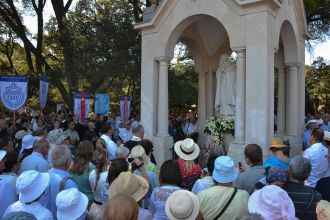
This year we celebrate the 20th Anniversary of the M.I. Traditional Observance. In Warsaw on the first Saturday of May 2000 (May 6th), Fr. Karl Stehlin enrolled the first 50 Knights into the Militia Immaculatæ, renewed according to the principles of St. Maximilian. The first Knights received the “dyplomik” (little diploma), a copy of the one written and signed by St. Maximilian himself.
This is how the Militia Immaculatæ Traditional Observance was initiated, and it was allowed to function by the then Superior General of the Society of St. Pius X, Bishop Bernard Fellay. He did this in accordance with the principles of substitute jurisdiction.
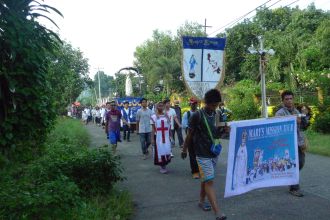
Why was the M.I. of Traditional Observance created?
On the eve of the Second Vatican Council, the Militia Immaculatæ had four million members in Poland and worldwide. In 1997 the new statutes of the M.I. were published and these were very different from those laid down by Fr. Maximilian Kolbe. One of the bestsellers of the time was a book by the General Moderator of the Militia, Fr. Simbula, who strongly criticized the holy founder for his narrowness and ‘being stuck in the opinions of his times’.
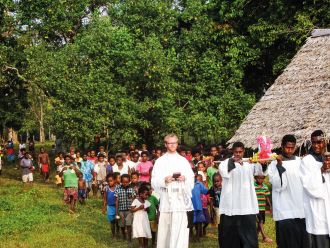
The M.I. after the Council
The revolution brought about by the Second Vatican Council did not spare the M.I. either:
- The name: they began by changing the supposedly all too-militant name of Militia (Knighthood) Immaculatæ to “Mission of the Immaculata”, so as to correspond better with the principles of religious freedom and conciliar pacifism.
Soon afterward, the Statutes were adapted to the spirit of the Council. The quotations in the new Statutes are taken exclusively from conciliar texts and the writings of Pope Paul VI and Pope John Paul II, along with a few quotations from St. Maximilian.
- The objectives: these revised Statutes present completely new objectives of the M.I. There is no longer any mention of the conversion of Freemasons, heretics, etc. Even the ejaculatory prayer of the M.I., “O Mary, conceived without sin, …” was deprived of its final clause, which the founder had added, i.e., “and for all those who do not have recourse to Thee, especially for the Freemasons and for all who have been commended to Thee”. The conversion of souls, the battle against error, and efforts to bring lapsed Catholics back into the bosom of Holy Mother Church are likewise no longer to be found in the Statutes. There is not a word about Satan, the archenemy of the Immaculata and of souls, and therefore, logically, no mention either of the salvation of souls, which must be snatched from the jaws of Hell at any cost.
- The essence: as for the essence of the M.I., there is still talk about total consecration to the Immaculata, but what this consecration involves concretely has been radically changed. Not a word about obedience to the will of the Immaculata; instead of the apostolate of spreading the true faith, the focus now is on activities designed to promote the dignity of the human person and to protect human life.
- The Mother of God: Mary is presented merely as an example and a model to be imitated. Otherwise, the new Statutes are silent about what St. Maximilian calls “the practical application of the dogma of the Immaculate Conception”, namely, her active role as Mediatrix of all graces (a truth which, since Vatican II, has been made out to be a debatable opinion), especially of the graces of conversion and sanctification. In this manner, what the founder regarded as the foundation of his entire project is being denied. “All of the work of the M.I. is based on the truth that Mary is the Mediatrix of all graces. If this were not the case, then our work and our efforts would be meaningless.” (Conference, 6th of June 1933).
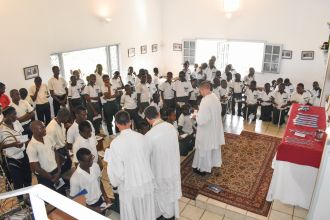
At the same time, young faithful in Poland asked whether the Militia Immaculatæ could be restarted
exactly as St. Maximilian had founded it. As Catholic Poland since the 1920s was deeply influenced by the M.I., the refounding of it exactly in the same spirit in which the Holy Founder established it was deemed essential.
A little prayer crusade was organized, so that the Immaculata would show us her will. The then Superior General of the Society of St. Pius X, Bishop Bernard Fellay, maintained that in accordance with the principles of substitute jurisdiction, this allowed for the establishment of the Militia Immaculatæ in its traditional form.
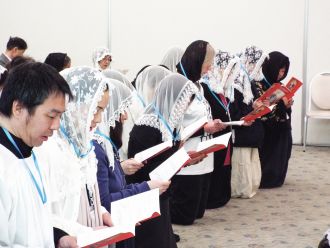
The fruits of this foundation were immediate: increase of generosity amongst the Knights, regular prayer life, and a renewed apostolic spirit, expressed especially in an intensive increase of the written apostolate (bulletins, books, brochures, flyers) which made the Catholic Tradition known in Poland.
Thanks to the publishing of the very texts of St. Maximilian Kolbe and his fellow Knights before the 2nd World War, many faithful could thus easily discern the immense difference and even contradiction between the novelties within the Church which the spirit of Vatican II had introduced, and the spirituality and ideals of the first 50 years of the M.I.
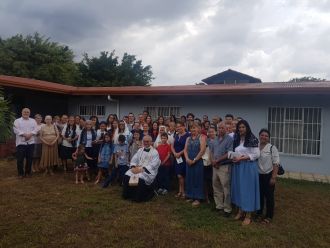
Development of M.I. traditional observance
In 2002 the traditional Capuchin Fathers of Morgon desired to join the M.I. and to found it in France. In 2004 the first American priests founded the M.I. in some priories and chapels of the US, followed in 2006, by Switzerland. But all these beginnings were simply the individual endeavours of supporters of St. Maximilian and the movement generally was unknown in the traditional world (except in Poland).
However, Our Lady herself wanted her little army to grow. Without any special advertisement or publicity, more and more faithful became interested, thanks to the publication of the brochures and books about the M.I. and the establishment of websites.
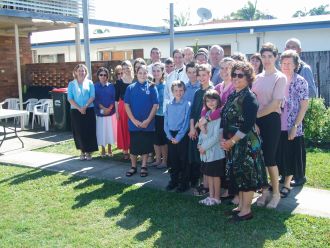
In 2013 there were 5,000 Knights, in 2016 — around 13,000 Knights, and in January 2020, the number rose to over 120,000 Knights worldwide.
For a long time the M.I. in the different countries was left to the M.I. priests who individually and on their own initiative tried “to do something” with the permission of their superiors. In order to unite the different efforts and to constitute the M.I. as a little army of the Catholic Tradition, the General Superior — the supreme authority of the M.I. — delegated Fr. Karl Stehlin as the International Moderator or in the terms of St. Maximilian ‘the Director’ of the M.I. in April 2016
Since then, Fr. Stehlin has visited more than 30 countries where he has preached conferences presenting the idea of the M.I. and the spirituality of St. Maximilian.
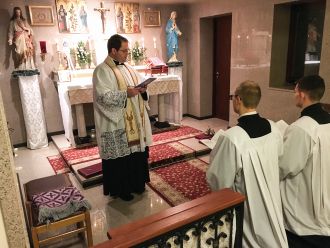
In many of them, he initiated the Knighthood of the Immaculate, e.g. in the Philippines, India, China, Japan, South Korea, Singapore, Malaysia, Indonesia, Australia, and recently in the Philippines, Peru, Colombia, Argentina, Paraguay, Chile, Mexico, Costa Rica, Guatemala, Gabon and Nigeria. Currently M.I. traditional observance exists and operates in 48 countries on all continents.
In November 2018, the present Superior General, Fr. Davide Pagliarani, allowed the establishment of the Headquarters of the M.I. in Warsaw.
You are encouraged to familiarize yourself with the activities of the M.I. in other countries whose representatives have prepared short presentations included in the “Knight if the Immaculata” No. 20.
Here the “Knight of the Immaculata” No. 20 for download









